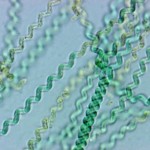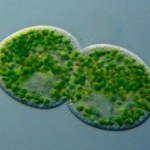By Dr. Bob McCauley
The most powerful foods on earth are Spirulina Plantensis and Chlorella Pyrenoidosa. They compliment one another in many ways because they are completely different foods with different nutrients. Spirulina is an extremely pure food, 95% digestible, extremely high in the Vitamin B-complex, iron, calcium and essential fatty acids such as Gamma Linolenic Acid (GLA), which is excellent for providing joint support and reducing joint inflammation. Spirulina is an excellent food to consume before a workout because of the explosive energy it provides to the body.
Advantages of Spirulina and Chlorella
Spirulina Nutrition
- Protein 60% – Highest of any food.
- Vitamins – A, C, E, B Complex
- Pycocyanin – Miracle Nutrient
- SOD– Antioxidant
- Zeaxanthin – Antioxidant
- Fatty Acids – GLA, DHA, Omega 3 & 6
- Phytonutrients – Beta-carotene, Chlorophyll
Spirulina Benefits
- High Energy Food
- Cardiovascular Health
- Clears + Strengthens Arteries & Veins
- Encourages Nutrient Assimilation
- Dietary Fiber Cleans Digestive Tract
- Assists with Weight Management
- Brain & Neurological Health
- Gives you Lots of Energy
- Restores Cellular Activity
- Helps balance Blood Sugar
- Cleanses + Repairs Liver
- Balances + Cleans Kidneys
- Reproductive Health
- One of only 2 Foods You Can Live On Exclusively and Be Healthy
Chlorella Nutrition
- Most Amino Acids: 60%
- Perfect Plant Protein
- Most Nucleic Acids (RNA/DNA)
- Cellular Repair Longevity
- Most Chlorophyll
- The Body’s Important Nutrient
- Vitamins A, B Complex, C, D, E, K1, Folic Acid
- Fat [6%] Alpha Linolenic, Oleic & Linoleic acids
- Mineral Dense [6.5%]
- Antioxidants
- Outer Cell Wall: Dietary Fiber binds with Toxins & pulls them from the Body
- Chlorella Growth Factor, CGF – Chlorella Extract, Powerhouse of the Chlorella Cell
Chlorella Benefits
- Gives you Lots of Energy
- Cardiovascular Health
- Clears + Strengthens Arteries & Veins
- Encourages Nutrient Assimilation
- Dietary Fiber Cleans Digestive Tract
- Brain & Neurological Health
- Gives you Lots of Energy
- Restores Cellular Activity
- Helps balance Blood Sugar
- Cleanses + Repairs Liver
- Balances + Cleans Kidneys
- Reproductive Health
- One of only 2 Foods You Can Live On Exclusively and Be Healthy
- LOW Heavy Metals
- Non-GMO
- Herbicide + Pesticide FREE
Chlorella has incredible immune building properties. Its unique fiber is great for the digestion, as well as heavy metal and synthetic toxin removal. It has large amounts of nucleic acids (RNA/DNA), which, along with amino acids (protein), are the building blocks of our cells. Chlorella can even be used topically on cuts, scrapes, infections, even serious wounds, as can Spirulina.
The second step in Achieving Great Health is to add these superfoods to your diet. Start slowly, gradually increasing them until you reach a dosage of at least eight grams of each daily. (See Appendix: Spirulina, Chlorella & Water Dosages.) You can never consume too much Spirulina and Chlorella as long as they are raw and their enzymes are intact. As you increase your dosage, gradually reduce your intake of protein from traditional sources, such as meat, fish, eggs, soy and dairy products. Algae is best consumed with each meal because of its high protein content, the highest percentage of any foods known with 18 different amino acids that are in the proper ratio to one another. Protein must be consumed with everything you eat for proper digestion and nutrient absorption. Most vegetarians lack sufficient protein in their diet.
Great Health will be nearly impossible to achieve without these two powerful whole foods at the center of your diet
Even though the nutritional profile of Spirulina or Chlorella are quite similar, they are completely different foods, as different as apples and oranges. Although many of the nutrients in these foods are identical, those same nutrients will assimilate and benefit the body in slightly different ways. This is why we should attempt to get as many different types of foods into our diet as possible.
Spirulina is a nitrogen-based blue-green alga and has the predominant odor of seaweed. Chlorella is a green alga that is oxygen-based and has the predominant odor of fresh grass. Chlorella gets its name from the high amount of chlorophyll in it, up to 10 times that of Spirulina, which is itself quite high in chlorophyll. Chlorella belongs to a class of algae called chlorophyta.
 Spirulina: High Energy
Spirulina: High Energy
Spirulina is an extremely high energy food, great before a work out. It also is excellent for the treatment of join problems. It is in a class of algae called cyanobacteria. As strains of algae, chlorophyta and cyanobacteria could not be more different from one another.
I take 5 grams of Spirulina before every workout and the difference is unmistakable. I can exercise harder, for a longer period of time, and recover quicker when I take Spirulina before a workout. Athletes who have discovered these superfoods and load-up on them before training or competition have a decided edge over those who don’t. I know many athletes who do this and the best thing about it is that it is completely natural and therefore legal. Athletes don’t need to worry about testing positive for steroids or other artificial substances if they pre-load on natural superfoods such as these before competition.
Chlorella: Detoxification
The fiber in Chlorella is famous for removing heavy metals and other synthetic toxins from the body. One of the absorbing substances in Chlorella fiber is sporopollenin, a naturally occurring carotene-like polymer that is extremely resistant to degradation. Chlorella’s cell wall is comprised of 3 layers. The middle layer contains the thickest cellulose microfibrils. The outer layer is extremely resistant to tearing or breakage. The characteristics of this fiber are unique to Chlorella and why it is so important that we consistently have Chlorella in our diet because it is not found in any other food source. Even dead Chlorella has the ability to soak up toxins after it has bonded with them.[i]
the body. One of the absorbing substances in Chlorella fiber is sporopollenin, a naturally occurring carotene-like polymer that is extremely resistant to degradation. Chlorella’s cell wall is comprised of 3 layers. The middle layer contains the thickest cellulose microfibrils. The outer layer is extremely resistant to tearing or breakage. The characteristics of this fiber are unique to Chlorella and why it is so important that we consistently have Chlorella in our diet because it is not found in any other food source. Even dead Chlorella has the ability to soak up toxins after it has bonded with them.[i]
[i] Bioconcentration of four pure BCB Isomers by Chlorella pyrenoidosa, Urey, J.C., et al. Bull Envir. Contam. Toxicol. 16, 1976, S. 81-85.

